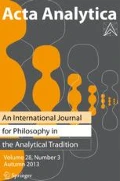Abstract
The notion that exploitation consists in taking wrongful advantage of another’s vulnerability is widespread in the philosophical literature. Considering the popularity of this view, it is disappointing to find that very few authors attempt to provide substantive accounts of characteristics they consider relevant vulnerabilities (i.e., those pertinent to exploitation), as well as of relevant features which make taking advantage of those vulnerabilities wrongful. In this paper, I analyze the few approaches (notably those presented by Ruth Sample and Robert Goodin) that in fact provide such accounts, and I examine whether and how they pertain to exploitation in general, as well as to exploitation in more personal/intimate relationships. I conclude that these vulnerability-based accounts of exploitation are either too vague or too restrictive, since they tend to leave out many instances of exploitation (especially those within personal and intimate relationships), and are as such inadequate.
Similar content being viewed by others
Notes
I would like to thank an anonymous referee for this objection.
The account of reflective equilibrium is introduced on p. 18.
I am grateful to an anonymous referee for insisting on addressing this issue.
For a useful overview of the literature on vulnerabilities in connection with health issues, see Ruof 2004.
Interestingly, Michael Kottow proposes notions of vulnerability and susceptibility that seem diametrically opposed to those put forward by Carse and Little. Kottow argues that being vulnerable is a descriptive characteristic of human beings qua humans: it means that we are fragile, but can be nevertheless intact (Kottow 2003, p. 281). To be susceptible, on the other hand, involves “being injured and predisposed to compound additional harm” (Kottow 2004, p. 460). However, I find that most authors understand these two notions as presented by Carse and Little, which is how I will be using them throughout this text.
This example is based on the motion picture Unhook the Stars (1997), directed by Nick Cassavetes, starring Gena Rowlands as Mildred and Marisa Tomei as Monica.
I have noticed that not everyone agrees that Susan has been wrongfully used in this example. If you find the scenario unconvincing, I suggest you sidestep it and focus on the example that follows this one (a rich man “buying” his mistress) which has so far yielded general agreement that it involves exploitation. While I feel that the two examples merit similar analyses, my overall criticism of vulnerability-based accounts persists as long as we can find at least some cases of exploitation which involve taking advantage of a mere desire, rather than a basic need.
References
Carse, A. L., & Little, M. O. (2008). Exploitation & enterprise of medical research. In E. J. Emanuel & J. S. Hawkins (Eds.), Exploitation and developing countries: The ethics of clinical research (pp. 206–245). Princeton: Princeton University Press.
Cleitman, R. (Producer), & Cassavetes, N. (Director). (1997). Unhook the Stars [Motion picture]. United States: Hachette Premiere and Miramax Films.
Davis, N. (1984). Using persons and common sense. Ethics, 94(3), 387–406.
Feinberg, J. (1983). Noncoercive exploitation. In R. Sartorius (Ed.), Paternalism (pp. 201–236). Minneapolis: University of Minnesota Press.
Feinberg, J. (1984). Harm to others: The moral limits of the criminal law. New York: Oxford University Press.
Feinberg, J. (1990). Harmless wrongdoing: The moral limits of the criminal law. New York: Oxford University Press.
Flaskerud, J. H., & Winslow, B. J. (1998). Conceptualizing vulnerable populations: Health-related research. Nursing Research, 47(2), 69–78.
Goodin, R. (1985). Protecting the vulnerable. Chicago: University of Chicago Press.
Goodin, R. (1987). Exploiting a situation and exploiting a person. In A. Reeve (Ed.), Modern theories of exploitation (pp. 166–200). London: Sage.
Harris, J. (1985). The value of life: An introduction to medical ethics. London: Routledge.
Khan, K. C., & Bryant, J. H. (1994). The vulnerable in developed and developing countries: A conceptual framework. Poverty, vulnerability, the value of human life, and the emergence of bioethics—highlights and papers of the XXVIIth CIOMS Conference, Ixtapa, Guerrero State, Mexico (pp. 183–202). Geneva: CIOMS.
Kopelman, L. (2004). Research policy: risk and vulnerable groups. In S. G. Post (Ed.), Encyclopedia of bioethics (pp. 2365–2372). Macmillan
Kottow, M. H. (2003). The vulnerable and the susceptible. Bioethics, 17(5–6), 460–471.
Kottow, M. H. (2004). Vulnerability: what kind of a principle is it? Medicine, Health Care and Philosophy, 7, 281–287.
Macklin, R. (2003). Bioethics, vulnerability, and protection. Bioethics, 17(5–6), 472–486.
Morawa, A. H. (2003). Vulnerability as a concept of international human rights law. Journal of International Relations and Development, 6(2), 139–155.
Nussbaum, M. (2000). Women and human development—the capabilities approach. Cambridge: Cambridge University Press.
Rawls, J. (1999). A theory of justice. Cambridge: Harvard University Press.
Richards, N. (1978). Using people. Mind, 87(345), 98–104.
Ruof, M. C. (2004). Vulnerability, vulnerable populations, and policy. Kennedy Institute of Ethics Journal, 14(4), 411–425.
Sample, R. (2003). Exploitation: What it is and why it’s wrong. Lanham: Rowman & Littlefield.
Schwartz, J. (1995). What’s wrong with exploitation? Noûs, 29(2), 158–188.
Thomasma, D. C. (2000). The vulnerability of the sick. Bioethics Forum, 16(2), 5–12.
Wertheimer, A. (1996). Exploitation. Princeton: Princeton University Press.
Werthemier, A. (1987). Coercion. Princeton: Princeton University Press.
Wilkinson, S. (2003). Bodies for sale: Ethics and exploitation in the human body trade. London: Routledge.
Wolff, J. (1999). Marx and exploitation. Journal of Ethics, 3(2), 105–120.
Wood, A. W. (1997). Exploitation. In K. Nielsen & R. Ware (Eds.), Exploitation—key concepts in critical theory (pp. 2–26). New Jersey: Humanities Press International.
Author information
Authors and Affiliations
Corresponding author
Rights and permissions
About this article
Cite this article
Logar, T. Exploitation as Wrongful Use: Beyond Taking Advantage of Vulnerabilities. Acta Anal 25, 329–346 (2010). https://doi.org/10.1007/s12136-010-0089-6
Received:
Accepted:
Published:
Issue Date:
DOI: https://doi.org/10.1007/s12136-010-0089-6




